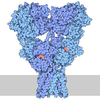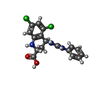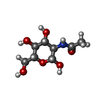+ データを開く
データを開く
- 基本情報
基本情報
| 登録情報 | データベース: PDB / ID: 6why | ||||||||||||
|---|---|---|---|---|---|---|---|---|---|---|---|---|---|
| タイトル | GluN1b-GluN2B NMDA receptor in complex with GluN1 antagonist L689,560, class 1 | ||||||||||||
 要素 要素 |
| ||||||||||||
 キーワード キーワード | MEMBRANE PROTEIN / NMDARs / Ligand-gated ion channels / METAL TRANSPORT / Ionotropic glutamate receptor / GluN1 antagonist | ||||||||||||
| 機能・相同性 |  機能・相同性情報 機能・相同性情報cellular response to curcumin / cellular response to corticosterone stimulus / cellular response to magnesium starvation / sensory organ development / pons maturation / positive regulation of Schwann cell migration / regulation of cell communication / EPHB-mediated forward signaling / sensitization / auditory behavior ...cellular response to curcumin / cellular response to corticosterone stimulus / cellular response to magnesium starvation / sensory organ development / pons maturation / positive regulation of Schwann cell migration / regulation of cell communication / EPHB-mediated forward signaling / sensitization / auditory behavior / Assembly and cell surface presentation of NMDA receptors / response to hydrogen sulfide / olfactory learning / conditioned taste aversion / dendritic branch / regulation of respiratory gaseous exchange / response to other organism / protein localization to postsynaptic membrane / regulation of ARF protein signal transduction / transmitter-gated monoatomic ion channel activity / fear response / apical dendrite / positive regulation of inhibitory postsynaptic potential / suckling behavior / response to methylmercury / response to glycine / propylene metabolic process / response to manganese ion / response to carbohydrate / interleukin-1 receptor binding / cellular response to dsRNA / negative regulation of dendritic spine maintenance / cellular response to lipid / response to growth hormone / regulation of monoatomic cation transmembrane transport / heterocyclic compound binding / NMDA glutamate receptor activity / positive regulation of glutamate secretion / Synaptic adhesion-like molecules / RAF/MAP kinase cascade / voltage-gated monoatomic cation channel activity / response to glycoside / NMDA selective glutamate receptor complex / neurotransmitter receptor complex / ligand-gated sodium channel activity / glutamate binding / response to morphine / calcium ion transmembrane import into cytosol / regulation of axonogenesis / neuromuscular process / regulation of dendrite morphogenesis / protein heterotetramerization / male mating behavior / glycine binding / regulation of synapse assembly / response to amine / receptor clustering / parallel fiber to Purkinje cell synapse / small molecule binding / regulation of cAMP/PKA signal transduction / startle response / positive regulation of reactive oxygen species biosynthetic process / monoatomic cation transmembrane transport / behavioral response to pain / positive regulation of calcium ion transport into cytosol / response to magnesium ion / regulation of postsynaptic membrane potential / regulation of neuron apoptotic process / regulation of MAPK cascade / action potential / associative learning / cellular response to glycine / extracellularly glutamate-gated ion channel activity / monoatomic cation transport / excitatory synapse / social behavior / positive regulation of dendritic spine maintenance / response to electrical stimulus / regulation of neuronal synaptic plasticity / monoatomic ion channel complex / positive regulation of excitatory postsynaptic potential / glutamate receptor binding / Unblocking of NMDA receptors, glutamate binding and activation / response to mechanical stimulus / long-term memory / detection of mechanical stimulus involved in sensory perception of pain / positive regulation of synaptic transmission, glutamatergic / behavioral fear response / synaptic cleft / multicellular organismal response to stress / neuron development / prepulse inhibition / postsynaptic density, intracellular component / phosphatase binding / monoatomic cation channel activity / calcium ion homeostasis / response to fungicide / glutamate-gated receptor activity / cell adhesion molecule binding / D2 dopamine receptor binding 類似検索 - 分子機能 | ||||||||||||
| 生物種 |  | ||||||||||||
| 手法 | 電子顕微鏡法 / 単粒子再構成法 / クライオ電子顕微鏡法 / 解像度: 4.03 Å | ||||||||||||
 データ登録者 データ登録者 | Chou, T. / Tajima, N. / Furukawa, H. | ||||||||||||
| 資金援助 |  米国, 2件 米国, 2件
| ||||||||||||
 引用 引用 |  ジャーナル: Cell / 年: 2020 ジャーナル: Cell / 年: 2020タイトル: Structural Basis of Functional Transitions in Mammalian NMDA Receptors. 著者: Tsung-Han Chou / Nami Tajima / Annabel Romero-Hernandez / Hiro Furukawa /  要旨: Excitatory neurotransmission meditated by glutamate receptors including N-methyl-D-aspartate receptors (NMDARs) is pivotal to brain development and function. NMDARs are heterotetramers composed of ...Excitatory neurotransmission meditated by glutamate receptors including N-methyl-D-aspartate receptors (NMDARs) is pivotal to brain development and function. NMDARs are heterotetramers composed of GluN1 and GluN2 subunits, which bind glycine and glutamate, respectively, to activate their ion channels. Despite importance in brain physiology, the precise mechanisms by which activation and inhibition occur via subunit-specific binding of agonists and antagonists remain largely unknown. Here, we show the detailed patterns of conformational changes and inter-subunit and -domain reorientation leading to agonist-gating and subunit-dependent competitive inhibition by providing multiple structures in distinct ligand states at 4 Å or better. The structures reveal that activation and competitive inhibition by both GluN1 and GluN2 antagonists occur by controlling the tension of the linker between the ligand-binding domain and the transmembrane ion channel of the GluN2 subunit. Our results provide detailed mechanistic insights into NMDAR pharmacology, activation, and inhibition, which are fundamental to the brain physiology. | ||||||||||||
| 履歴 |
|
- 構造の表示
構造の表示
| ムービー |
 ムービービューア ムービービューア |
|---|---|
| 構造ビューア | 分子:  Molmil Molmil Jmol/JSmol Jmol/JSmol |
- ダウンロードとリンク
ダウンロードとリンク
- ダウンロード
ダウンロード
| PDBx/mmCIF形式 |  6why.cif.gz 6why.cif.gz | 538.3 KB | 表示 |  PDBx/mmCIF形式 PDBx/mmCIF形式 |
|---|---|---|---|---|
| PDB形式 |  pdb6why.ent.gz pdb6why.ent.gz | 396.4 KB | 表示 |  PDB形式 PDB形式 |
| PDBx/mmJSON形式 |  6why.json.gz 6why.json.gz | ツリー表示 |  PDBx/mmJSON形式 PDBx/mmJSON形式 | |
| その他 |  その他のダウンロード その他のダウンロード |
-検証レポート
| 文書・要旨 |  6why_validation.pdf.gz 6why_validation.pdf.gz | 1.2 MB | 表示 |  wwPDB検証レポート wwPDB検証レポート |
|---|---|---|---|---|
| 文書・詳細版 |  6why_full_validation.pdf.gz 6why_full_validation.pdf.gz | 1.3 MB | 表示 | |
| XML形式データ |  6why_validation.xml.gz 6why_validation.xml.gz | 86.4 KB | 表示 | |
| CIF形式データ |  6why_validation.cif.gz 6why_validation.cif.gz | 130.1 KB | 表示 | |
| アーカイブディレクトリ |  https://data.pdbj.org/pub/pdb/validation_reports/wh/6why https://data.pdbj.org/pub/pdb/validation_reports/wh/6why ftp://data.pdbj.org/pub/pdb/validation_reports/wh/6why ftp://data.pdbj.org/pub/pdb/validation_reports/wh/6why | HTTPS FTP |
-関連構造データ
| 関連構造データ |  21680MC 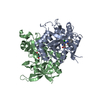 6usuC 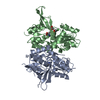 6usvC  6whrC  6whsC  6whtC  6whuC  6whvC  6whwC  6whxC  6wi0C  6wi1C M: このデータのモデリングに利用したマップデータ C: 同じ文献を引用 ( |
|---|---|
| 類似構造データ |
- リンク
リンク
- 集合体
集合体
| 登録構造単位 | 
|
|---|---|
| 1 |
|
- 要素
要素
| #1: タンパク質 | 分子量: 108085.633 Da / 分子数: 2 / 由来タイプ: 組換発現 / 由来: (組換発現)  発現宿主:  参照: UniProt: P35439*PLUS #2: タンパク質 | 分子量: 98845.859 Da / 分子数: 2 / 由来タイプ: 組換発現 / 由来: (組換発現)  発現宿主:  参照: UniProt: Q00960*PLUS #3: 多糖 | #4: 化合物 | #5: 糖 | 研究の焦点であるリガンドがあるか | Y | Has protein modification | Y | |
|---|
-実験情報
-実験
| 実験 | 手法: 電子顕微鏡法 |
|---|---|
| EM実験 | 試料の集合状態: PARTICLE / 3次元再構成法: 単粒子再構成法 |
- 試料調製
試料調製
| 構成要素 | 名称: NMDA receptor GluN1b/2B functional ion channel complex タイプ: COMPLEX / Entity ID: #1-#2 / 由来: RECOMBINANT |
|---|---|
| 由来(天然) | 生物種:  |
| 由来(組換発現) | 生物種:  |
| 緩衝液 | pH: 7.5 |
| 試料 | 包埋: NO / シャドウイング: NO / 染色: NO / 凍結: YES |
| 急速凍結 | 装置: FEI VITROBOT MARK IV / 凍結剤: ETHANE / 湿度: 85 % / 凍結前の試料温度: 295 K |
- 電子顕微鏡撮影
電子顕微鏡撮影
| 実験機器 |  モデル: Titan Krios / 画像提供: FEI Company |
|---|---|
| 顕微鏡 | モデル: FEI TITAN KRIOS |
| 電子銃 | 電子線源:  FIELD EMISSION GUN / 加速電圧: 300 kV / 照射モード: FLOOD BEAM FIELD EMISSION GUN / 加速電圧: 300 kV / 照射モード: FLOOD BEAM |
| 電子レンズ | モード: BRIGHT FIELD |
| 撮影 | 電子線照射量: 64.5 e/Å2 フィルム・検出器のモデル: GATAN K2 SUMMIT (4k x 4k) |
- 解析
解析
| EMソフトウェア | 名称: cisTEM / バージョン: 1.0.0 / カテゴリ: 3次元再構成 |
|---|---|
| CTF補正 | タイプ: PHASE FLIPPING AND AMPLITUDE CORRECTION |
| 対称性 | 点対称性: C2 (2回回転対称) |
| 3次元再構成 | 解像度: 4.03 Å / 解像度の算出法: FSC 0.143 CUT-OFF / 粒子像の数: 194228 / 対称性のタイプ: POINT |
 ムービー
ムービー コントローラー
コントローラー












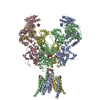
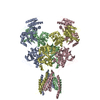


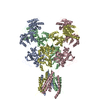
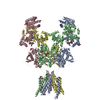
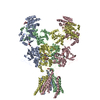

 PDBj
PDBj